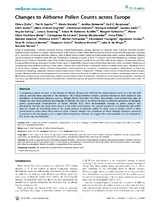Changes to Airborne Pollen Counts across Europe

Ver/
Autor
Ziello, Chiara
Sparks, Tim H.
Estrella, Nicole
Belmonte, Jordina
Bergmann, Karl C.
Bucher, Edith
Brighetti, Maria Antonia
Damialis, Athanasios
Detandt, Monique
Galán, Carmen
Gehrig, Regula
Grewling, Lukasz
Gutiérrez Bustillo, Adela M.
Hallsdóttir, Margrét
Kockhans-Bieda, Marie-Claire
De Linares, C.
Myszkowska, Dorota
Pàldy, Anna
Sánchez, Adriana
Smith, Matthew
Thibaudon, Michel
Travaglini, Alessandro
Uruska, Agnieszka
Valencia-Barrera, R.M.
Vokou, Despoina
Wachter, Reinhard
Weger, Letty A. de
Menzel, Annette
Editor
Public Library Of Science (PLOS)Fecha
2012Materia
AerobiologíaPolen
Europa
Allergic diseases
Pollen
Climate change
METS:
Mostrar el registro METSPREMIS:
Mostrar el registro PREMISMetadatos
Mostrar el registro completo del ítemResumen
A progressive global increase in the burden of allergic diseases has affected the industrialized world over the last half
century and has been reported in the literature. The clinical evidence reveals a general increase in both incidence and
prevalence of respiratory diseases, such as allergic rhinitis (common hay fever) and asthma. Such phenomena may be
related not only to air pollution and changes in lifestyle, but also to an actual increase in airborne quantities of allergenic
pollen. Experimental enhancements of carbon dioxide (CO2) have demonstrated changes in pollen amount and
allergenicity, but this has rarely been shown in the wider environment. The present analysis of a continental-scale pollen
data set reveals an increasing trend in the yearly amount of airborne pollen for many taxa in Europe, which is more
pronounced in urban than semi-rural/rural areas. Climate change may contribute to these changes, however increased
temperatures do not appear to be a major influencing factor. Instead, we suggest the anthropogenic rise of atmospheric
CO2 levels may be influential
